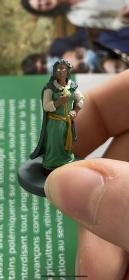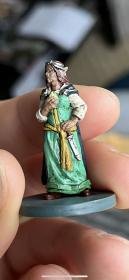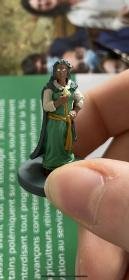Hi all,
I recently started painting some miniatures for the Lord of the rings: Journeys in middle earth and am still quite the rookie. I was hoping someone could give me some tips on the shading. This is usually my last step as I don’t really have time to finish with highlights etc (for now). However, I find that my shading technique (practically non-existent but I watched some videos), doesn’t work well on brighter colours, mostly when they are larger areas. It gives it a very “dirty” look. I didn’t mind this at first as I was mostly doing villains first, and it kind of looks nice when your orc has this dirt everywhere to give it a bit more of a rough-looking edge. However, on some of the heroes it kind of ruins the idea I had in mind. This Arwen I did recently is a great example and I was hoping someone could give me some tips for future work. Thanks!
The first photo is before I did the shading (note, I fix the eyes at the end). The second one is after shading, and you can see it looks like she’s been rolling around in the dirt like a pig rather than healing the crew… especially noticeable on the dress and white shirt (although for some reason her face also looks melted). Am I just rushing my shading too much? I find that if I don’t add shading to those areas, the contrast is too large as the base colours look very matte, while the shading makes things much more glossy.
Thanks in advance!
Shiv
I recently started painting some miniatures for the Lord of the rings: Journeys in middle earth and am still quite the rookie. I was hoping someone could give me some tips on the shading. This is usually my last step as I don’t really have time to finish with highlights etc (for now). However, I find that my shading technique (practically non-existent but I watched some videos), doesn’t work well on brighter colours, mostly when they are larger areas. It gives it a very “dirty” look. I didn’t mind this at first as I was mostly doing villains first, and it kind of looks nice when your orc has this dirt everywhere to give it a bit more of a rough-looking edge. However, on some of the heroes it kind of ruins the idea I had in mind. This Arwen I did recently is a great example and I was hoping someone could give me some tips for future work. Thanks!
The first photo is before I did the shading (note, I fix the eyes at the end). The second one is after shading, and you can see it looks like she’s been rolling around in the dirt like a pig rather than healing the crew… especially noticeable on the dress and white shirt (although for some reason her face also looks melted). Am I just rushing my shading too much? I find that if I don’t add shading to those areas, the contrast is too large as the base colours look very matte, while the shading makes things much more glossy.
Thanks in advance!
Shiv
Attachments
Last edited:







